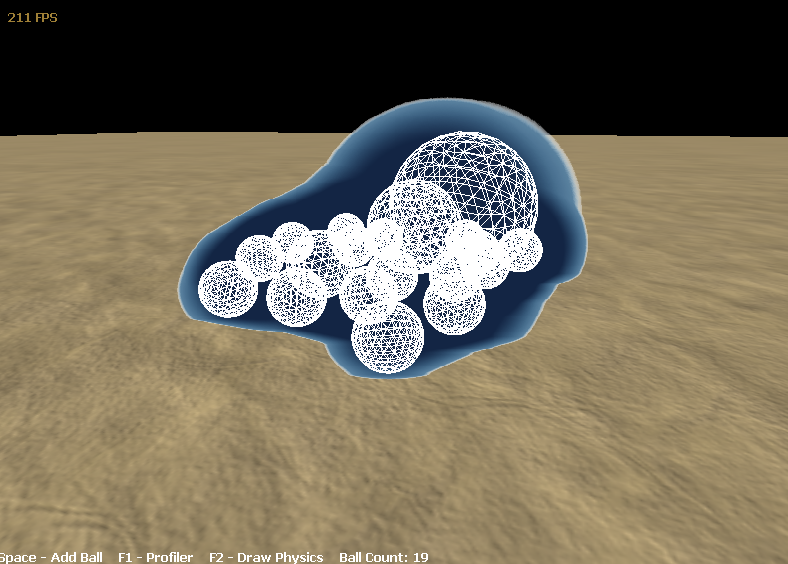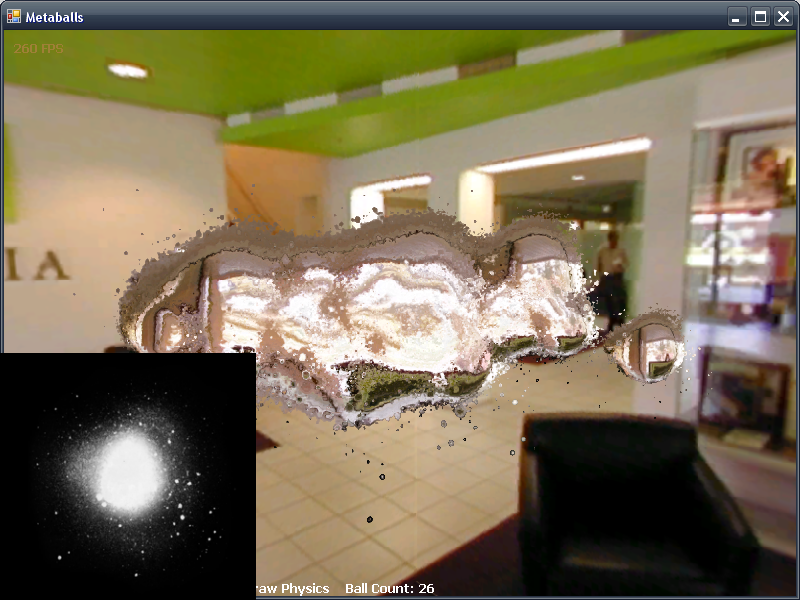 The technique is described in that thread, however, I apply it to 3D:
-Create a plethora of billboards with a texture that represents the metaball's charge.
-Render all the billboards using additive blending to a render target.
-Combine said render target to the scene using a shader. The shader checks if the metaballs charge is > than the threshold - if so, it is rendered. (I actually cheat and use saturate(Charge - Threshold) / (1.0f - Threshold) to smooth it out instead.)
-Color the metaballs.
In the demo I provided, it's slowed down significantly by physics, but the technique is very fast, and is basically dependent on your fill rate. However, your metaballs may appear different depending on camera angle.
If someone has the performance to spare, I'd imagine that a really good looking water simulation could be made out of this and a low threshold. Also, someone far more intelligent than me can probably figure out how to extract world-space normals from the billboards, allowing for cubemap reflections and a million other fancy effects.
Tell me what you think!
The technique is described in that thread, however, I apply it to 3D:
-Create a plethora of billboards with a texture that represents the metaball's charge.
-Render all the billboards using additive blending to a render target.
-Combine said render target to the scene using a shader. The shader checks if the metaballs charge is > than the threshold - if so, it is rendered. (I actually cheat and use saturate(Charge - Threshold) / (1.0f - Threshold) to smooth it out instead.)
-Color the metaballs.
In the demo I provided, it's slowed down significantly by physics, but the technique is very fast, and is basically dependent on your fill rate. However, your metaballs may appear different depending on camera angle.
If someone has the performance to spare, I'd imagine that a really good looking water simulation could be made out of this and a low threshold. Also, someone far more intelligent than me can probably figure out how to extract world-space normals from the billboards, allowing for cubemap reflections and a million other fancy effects.
Tell me what you think!
Image-Space 3D Metaballs
After coming across this thread, I had an idea - if this technique can be applied to a 2D game, why haven't I seen it in a 3D one?
So, I set out to create a demo of it in 3D this morning. Click me to download.
 The technique is described in that thread, however, I apply it to 3D:
-Create a plethora of billboards with a texture that represents the metaball's charge.
-Render all the billboards using additive blending to a render target.
-Combine said render target to the scene using a shader. The shader checks if the metaballs charge is > than the threshold - if so, it is rendered. (I actually cheat and use saturate(Charge - Threshold) / (1.0f - Threshold) to smooth it out instead.)
-Color the metaballs.
In the demo I provided, it's slowed down significantly by physics, but the technique is very fast, and is basically dependent on your fill rate. However, your metaballs may appear different depending on camera angle.
If someone has the performance to spare, I'd imagine that a really good looking water simulation could be made out of this and a low threshold. Also, someone far more intelligent than me can probably figure out how to extract world-space normals from the billboards, allowing for cubemap reflections and a million other fancy effects.
Tell me what you think!
The technique is described in that thread, however, I apply it to 3D:
-Create a plethora of billboards with a texture that represents the metaball's charge.
-Render all the billboards using additive blending to a render target.
-Combine said render target to the scene using a shader. The shader checks if the metaballs charge is > than the threshold - if so, it is rendered. (I actually cheat and use saturate(Charge - Threshold) / (1.0f - Threshold) to smooth it out instead.)
-Color the metaballs.
In the demo I provided, it's slowed down significantly by physics, but the technique is very fast, and is basically dependent on your fill rate. However, your metaballs may appear different depending on camera angle.
If someone has the performance to spare, I'd imagine that a really good looking water simulation could be made out of this and a low threshold. Also, someone far more intelligent than me can probably figure out how to extract world-space normals from the billboards, allowing for cubemap reflections and a million other fancy effects.
Tell me what you think!
 The technique is described in that thread, however, I apply it to 3D:
-Create a plethora of billboards with a texture that represents the metaball's charge.
-Render all the billboards using additive blending to a render target.
-Combine said render target to the scene using a shader. The shader checks if the metaballs charge is > than the threshold - if so, it is rendered. (I actually cheat and use saturate(Charge - Threshold) / (1.0f - Threshold) to smooth it out instead.)
-Color the metaballs.
In the demo I provided, it's slowed down significantly by physics, but the technique is very fast, and is basically dependent on your fill rate. However, your metaballs may appear different depending on camera angle.
If someone has the performance to spare, I'd imagine that a really good looking water simulation could be made out of this and a low threshold. Also, someone far more intelligent than me can probably figure out how to extract world-space normals from the billboards, allowing for cubemap reflections and a million other fancy effects.
Tell me what you think!
The technique is described in that thread, however, I apply it to 3D:
-Create a plethora of billboards with a texture that represents the metaball's charge.
-Render all the billboards using additive blending to a render target.
-Combine said render target to the scene using a shader. The shader checks if the metaballs charge is > than the threshold - if so, it is rendered. (I actually cheat and use saturate(Charge - Threshold) / (1.0f - Threshold) to smooth it out instead.)
-Color the metaballs.
In the demo I provided, it's slowed down significantly by physics, but the technique is very fast, and is basically dependent on your fill rate. However, your metaballs may appear different depending on camera angle.
If someone has the performance to spare, I'd imagine that a really good looking water simulation could be made out of this and a low threshold. Also, someone far more intelligent than me can probably figure out how to extract world-space normals from the billboards, allowing for cubemap reflections and a million other fancy effects.
Tell me what you think!
It's not too hard to add normals. Basically when you're rendering your billboards, you need to calculate xy values such that x and y are of the range[-1, 1] (where (-1, -1) is the bottom left corner of your quad, and so on). Then you output these x and y values along with your weight value (height), and you scale x and y by the weight.
Then in your final pass where you sample the summed weights, you can calculate a normal like this:
Of course you may need to negate your Z depending on your coordinate system.
This is a screen from a little demo I made with this technique a while back:

float dist = length(xyPos);float weight = CalcGaussianWeight(dist);xyPos *= weight;return float4(xyPos, 0, weight);Then in your final pass where you sample the summed weights, you can calculate a normal like this:
float3 normal = normalize(float3(sample.x/sample.w, sample.y/sample.w, max(sample.w - 0.08f, 0)));Of course you may need to negate your Z depending on your coordinate system.
This is a screen from a little demo I made with this technique a while back:

Awesome - helpful as always, MJP.
I decided to use cubemap reflections, a non-spherical (paint splat) heightmap/brush, with normals:

[Edited by - Akitsune on March 10, 2010 3:59:09 AM]
I decided to use cubemap reflections, a non-spherical (paint splat) heightmap/brush, with normals:

[Edited by - Akitsune on March 10, 2010 3:59:09 AM]
this is awesome! I currently used raycasting combined with spatial hashing on the GPU to make realtime 3D metaballs but this is so much simpler :)
I will give this a try for sure!
edit:
anyways I am curious what happens if you move the camera? does that look weird?
I will give this a try for sure!
edit:
anyways I am curious what happens if you move the camera? does that look weird?
Quote: Original post by mokaschitta
this is awesome! I currently used raycasting combined with spatial hashing on the GPU to make realtime 3D metaballs but this is so much simpler :)
I will give this a try for sure!
edit:
anyways I am curious what happens if you move the camera? does that look weird?
this is awesome! I currently used raycasting combined with spatial hashing on the GPU to make realtime 3D metaballs but this is so much simpler :)
I will give this a try for sure!
edit:
anyways I am curious what happens if you move the camera? does that look weird?
Thanks! No, not like you'd expect from a billboard method - that's what makes it pretty neat.
Updated the demo, WASD to see for yourself:
http://astraios.net/test/Meta.zip
I'd share the source, but I'm using 3D middleware and it's horribly organized. If someone REALLY wants it, just ask.
PS: Try changing the Drop.png texture to any other grayscale picture.
edit: fixed to new link, source included
Hey,
I am on a mac, so I cant test your demo. Anyways I thought about the method a little more and correct me if I am wrong:
this method interprets all metaballs having the same z value right? I could move one metaball in front of all the others.
An also no matter how far away a metaball is, it will contribute to the current pixel due to the additive blending.
Did you solve that anyhow or is that a limitation you have to take when using this method?
I am on a mac, so I cant test your demo. Anyways I thought about the method a little more and correct me if I am wrong:
this method interprets all metaballs having the same z value right? I could move one metaball in front of all the others.
An also no matter how far away a metaball is, it will contribute to the current pixel due to the additive blending.
Did you solve that anyhow or is that a limitation you have to take when using this method?
Right. I render the billboards using back-front sorting, so the z position is proper.
Correct - metaballs contribute from any distance. This is a limitation, but it isn't a huge one and is barely noticeable - this is what the threshold and billboard size should be adjusted to minimize artifacts. I'm working on adding depth so I can retrieve the world position from the metaballs and eventually use triplanar texturing which like likely have artifacts due to this.
Correct - metaballs contribute from any distance. This is a limitation, but it isn't a huge one and is barely noticeable - this is what the threshold and billboard size should be adjusted to minimize artifacts. I'm working on adding depth so I can retrieve the world position from the metaballs and eventually use triplanar texturing which like likely have artifacts due to this.
cool, let us know how it works out. if you get correct depth to work somehow this is a neat method.
I want to be able to move metaballs in front of each other without resulting in one big blob (as it would be with this method).
I want to be able to move metaballs in front of each other without resulting in one big blob (as it would be with this method).
I tried your demo on Windows 7 x64 and it gives me an error saying that is is not a valid Win32 application.
This topic is closed to new replies.
Advertisement
Popular Topics
Advertisement







